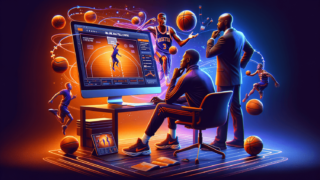What Are 17s in Basketball?
Written by: Basketball Universe
Last updated:
Today, we’re diving into the world of “17s,” an invaluable term that’s as intriguing as it sounds in the exciting game of basketball. If you’ve ever found yourself puzzled, wondering what 17s are, or seeking to obtain a deeper understanding of the game, you’ve landed in the perfect place! In this fun and informative blog post, we’ll explore what 17s in basketball represent, their incredible impact on players’ development, and how being well-versed with this fascinating concept transforms you into an ultimate basketball aficionado. So buckle up, as we’re about to embark on a captivating journey to unravel the mysteries of the cherished and beloved game of basketball!
What Are 17s in Basketball?
17s in basketball refers to a conditioning drill designed to boost players’ stamina and endurance. Played on a full-length court, this high-intensity workout requires players to complete 17 sprints, touching the sidelines for each change of direction. It’s a popular and efficient way for teams to practice agility, speed, and most importantly, develop impressive cardiovascular endurance for game situations.
The Evolution of the 17s Basketball Drill
Originating in the 1980s, thanks to renowned basketball coaches, the 17s drill has become a mainstay in basketball training regimens across the globe. While many exercises have been adapted, modified, and transformed, the 17s drill remains largely unchanged, standing the test of time, and continuing to provide immense value to basketball players.
How to Perform the 17s Drill
As a classic conditioning exercise, the 17s drill is incredibly easy to set up and execute, making it accessible for basketball players at all levels. Follow these simple steps to perform the 17s drill correctly:
Step 1: Set Up the Court
Begin by lining up on one sideline of the basketball court. Make sure you have enough space to move swiftly without colliding with other players or encroaching upon the court’s boundaries. If you have a coach or partner timing you, ensure they are prepared with a stopwatch or other timing device.
Step 2: Sprint Across the Court
Sprinting from one sideline to the other, touch the opposite sideline with your hand, and change direction to run back to the starting sideline. Each sideline touch counts as one sprint. The objective of this drill is to complete 17 sprints as quickly as possible.
Step 3: Maintain Consistent and Controlled Effort
Throughout the entire drill, try to maintain consistent effort and pacing. This will ensure you maximize the cardiovascular benefits and build up your stamina effectively. It’s essential not to sprint too fast in the beginning and burn out before finishing the drill. Find a rhythm that sustains the intensity while enabling you to complete all 17 sprints.
Benefits of the 17s Drill
Implementing the 17s drill into your routine offers numerous advantages for your basketball performance. Let’s take a closer look at some of the key benefits this exercise brings:
1. Improved Cardiovascular Endurance
Completing the 17s drill challenges your cardiovascular system, resulting in increased stamina and endurance, which transfer directly to your basketball performance. A strong cardiovascular foundation allows players to maintain a high level of intensity throughout the game and avoid fatigue.
2. Increased Speed and Agility
The 17s drill requires multiple changes of direction at high speeds, improving your ability to make quick decisions and execute rapid movements on the court. Improved speed and agility allow you to outmaneuver opponents and react faster to dynamic game situations.
3. Enhanced Mental Toughness
Pushing yourself to the limit during the 17s drill helps develop mental toughness, an essential trait of top-performing athletes. The ability to maintain focus and determination while facing fatigue and exhaustion is a priceless attribute that gives you a competitive edge in basketball.
Variations of the 17s Drill
While the basic framework of the 17s drill has remained the same over the years, some variations can further challenge and provide additional benefits to basketball players. Here are some variations you can try:
1. Dribbling Variation
Incorporating dribbling into the 17s drill elevates the level of difficulty while improving your dribbling skills. Dribble the basketball while sprinting across the court, executing crossovers, behind-the-back dribbles, and other ball-handling techniques to enhance your skill set.
2. Defensive Slide Variation
Rather than sprinting, incorporate defensive slides as you move laterally across the court. This involves staying in a low defensive stance, maintaining a wide base, and shuffling your feet quickly without crossing them. This variation emphasizes defensive footwork and positioning.
3. Shooting Variation
Integrate shooting into the drill by adding a shot after completing a certain number of sprints. For instance, every 5 sprints, take a shot at the basket before resuming the drill. This forces you to quickly transition from a sprint to a jump shot, improving your ability to shoot under pressure.
Tracking Progress and Setting Goals
It’s essential to track your progress with the 17s drill to continually challenge yourself and evaluate improvements. Consider setting benchmarks and goals to ensure you’re pushing yourself, and monitor your development over time:
1. Timing the Drill
Using a stopwatch or similar device, record the time it takes to complete the entire 17s drill. Remember that completing the drill within a specific deadline can help improve your performance under time constraints, akin to game situations.
2. Evaluating Form and Technique
Stay mindful of your running form and body movements throughout the 17s drill. Strive for efficiency and proper technique, as this will carry over into your basketball performance.
3. Setting Personal Goals
Establish periodic goals based on your skill level, physical fitness, and the intensity of your training program. Use these goals to challenge yourself and stay engaged in your progress.
4. Reassessing and Adjusting Goals
As your fitness and skill level improve, reassess your goals and adjust them accordingly. Continually challenging yourself is key to reaching your potential in the game of basketball.
Incorporating the 17s Drill into Your Training Routine
To maximize the benefits of the 17s drill, it’s important to incorporate it into your regular basketball training program. Here are a few ideas to do so effectively:
1. Warm-Up or Cool-Down
Use the 17s drill as part of your warm-up to increase your heart rate and prepare your body for an intense workout. Alternatively, include it in your cool-down routine to reinforce your stamina and endurance.
2. Integrating with Other Conditioning Drills
Combine the 17s drill with other conditioning exercises to create a comprehensive workout aimed at developing speed, strength, and endurance – all essential aspects of basketball performance.
3. Interval Training
Incorporate the 17s drill into an interval training program, alternating between high and low-intensity exercises. This type of training can lead to significant improvements in your overall conditioning and fitness levels.
Final Thoughts
The 17s drill is a tried-and-true method of conditioning for basketball players looking to boost their endurance, speed, agility, and mental toughness. By understanding the drill’s benefits and incorporating it into your training program, you can elevate your basketball performance and achieve greater success on the court. Remember to track progress, set personal goals, and continually challenge yourself to become the best player you can be.
Strategies to Improve 17s Performance
Once you’ve incorporated the 17s drill into your basketball training routine, you may be seeking ways to enhance your performance further. Here are a few strategies to help you excel in the 17s and yield even better results:
1. Strength Training
Engage in regular strength training exercises that target the muscles used during the 17s drill, such as squats, lunges, and deadlifts. By strengthening your lower body muscles, you’ll enable yourself to generate more power and speed during the sprints.
2. Plyometric Exercises
Plyometrics, or jump training, can greatly impact your speed and agility in the 17s drill. Incorporate exercises like box jumps, hurdle hops, and bounding into your workout routine to develop explosive power and improve your performance in the drill.
3. Flexibility and Mobility
Improving your flexibility and mobility can help you maintain proper form and prevent injuries during the 17s drill. Stretch regularly before and after workouts, focusing on your hips, hamstrings, and quadriceps. Additionally, invest time in massages and foam rolling to speed up muscle recovery and enhance your overall mobility.
4. Proper Breathing Techniques
Optimizing your breathing technique during the 17s drill can lead to increased endurance and faster recovery times. Try diaphragmatic breathing, which involves deep breaths that expand your diaphragm rather than shallow chest breathing. This allows for better oxygen delivery to your muscles and improved performance during the drill.
Adapting the 17s Drill for Beginners
If you’re new to basketball training or just starting your fitness journey, the 17s drill may initially appear daunting. But don’t worry! You can adapt the drill to a comfortable intensity while building up your stamina and endurance, ultimately preparing you to tackle the full 17s in due course.
1. Start with Fewer Sprints
Begin by performing a lower number of sprints, such as 5 or 10, and gradually increase the number over time as your endurance improves. This allows you to slowly build up your stamina without being discouraged by an initially challenging exercise.
2. Modify the Intensity
Rather than sprinting at full-speed, consider jogging or power walking across the court. As your fitness level improves, you can gradually increase the pace and intensity of the drill.
3. Breaks and Recovery
If needed, incorporate brief breaks during the drill to catch your breath and recover. Over time, as your endurance improves, aim to reduce the length and number of breaks while executing the 17s drill.
Inspiring Examples of 17s in Action
Seeing basketball players excel in the 17s drill can inspire you to push your own limits and strive for greatness. Several famous basketball stars and teams have incorporated the 17s workout into their regimen, showcasing impressive results on the court.
1. NBA Fitness Programs
Many professional basketball teams, including numerous NBA franchises, regularly incorporate the 17s drill into their off-season and pre-season training programs. This displays the broad recognition of the drill’s effectiveness and its role in promoting peak performance at the highest level of the game.
2. College Basketball Programs
Top-tier college basketball programs, known for producing NBA-ready talent, also have integrated the 17s drill into their conditioning routines. These programs use the drill to build the stamina and endurance required for high-level competition and to prepare student-athletes for potential professional careers in basketball.
3. International Basketball Teams
Basketball has a global presence, and the 17s drill is widely acknowledged in international basketball circuits as well. From European leagues to FIBA competitions, the 17s workout is widely embraced to develop players capable of competing at elite levels across the globe.
Conclusion
Whether you’re a beginner or a seasoned basketball player, the 17s drill is an effective and time-tested method for improving your stamina, endurance, speed, and agility. By integrating the exercise into your training routine, exploring variations, and gradually challenging yourself with advanced adaptations, you can lay the foundation for basketball success, regardless of your current skill level. Remember, consistency and continuous improvement are key factors to excel in the beloved game of basketball!
FAQ Section: Your 17s Basketball Drill Questions Answered
Given the popularity and effectiveness of the 17s basketball drill, it’s no surprise that many questions arise regarding its use and application. Below, you’ll find answers to some of the most frequently asked questions related to the 17s drill, providing further insight and guidance to help you succeed on the court.
1. How often should I perform the 17s drill?
The frequency of the 17s drill depends on your training schedule, fitness level, and individual goals. Aim for 2-3 times per week, ensuring you have adequate rest and recovery days between drill sessions to prevent over-exertion and potential injuries.
2. Can I perform the 17s drill indoors?
Yes, the 17s drill can be performed indoors, provided you have ample space, such as a full basketball court, gymnasium, or large workout area. The key is to maintain the same dimensions and setup as an outdoor basketball court to replicate the proper distance and environment.
3. Can I do the 17s drill without a basketball court or limited space?
If a full court is unavailable, you can still perform modified versions of the 17s drill. Simply adjust the distance you’re sprinting to fit the available space, and record the new dimensions. Make sure to maintain a consistent number of sprints to preserve the essence of the drill.
4. Can the 17s drill help me lose weight?
Since the 17s drill is a high-intensity workout, it can indeed help burn calories and contribute to weight loss. However, weight management also depends on your diet and overall physical activity, so incorporating other workouts and maintaining a balanced diet is essential for achieving weight loss goals.
5. How can I motivate myself to perform the 17s drill?
Setting personal goals, tracking progress, and rewarding yourself when goals are achieved can significantly boost motivation. Additionally, consider partnering with a friend or teammate to perform the drill together, adding a competitive element while holding each other accountable.
6. How long should it take to complete the 17s drill?
The time it takes to complete the 17s drill varies by individual, with factors such as fitness level, sprint speed, and technique playing a role. As you improve, aim to complete the drill faster, setting personal time benchmarks to pursue and surpass.
7. Can I perform the 17s drill if I have an injury?
If you’re dealing with an injury, consult with a medical professional or a certified athletic trainer before attempting the 17s drill. They may provide modifications or recommend alternative exercises to accommodate your injury while still helping you build your basketball conditioning.
8. Will the 17s drill improve my basketball game?
Yes, the 17s drill can help improve your basketball performance by boosting your stamina, endurance, speed, and agility. These qualities translate directly to the basketball court, allowing you to maintain a high level of intensity during games and giving you a competitive edge.
9. How much rest should I take between 17s sessions?
Allow 48 hours of rest between 17s sessions to ensure your muscles have sufficient time to recover and reduce the risk of overtraining. This rest period may vary depending on your fitness level and training plan, so adjust accordingly to suit your individual needs.
10. Can beginners do the 17s drill?
Yes, beginners can perform the 17s drill by starting with fewer sprints, modifying the intensity, and incorporating breaks as necessary. Gradually increase the difficulty over time as your endurance and fitness level improve.
11. What are the benefits of incorporating variations of the 17s drill?
Variations of the 17s drill can help target specific basketball skills and enhance overall fitness. Adding dribbling, defensive slides, or shooting elements to the drill can help you develop a well-rounded skill set while diversifying your training routine.
12. I’m already fit – should I still do the 17s drill?
Even if you’re already in good shape, the 17s drill can still contribute to your basketball-specific conditioning. It targets endurance, speed, and agility in a way that simulates on-court situations, providing unique benefits that apply directly to basketball performance.
13. Can I incorporate other sports-specific skills into the 17s drill?
Although the 17s drill is designed specifically for basketball conditioning, you could adapt the concept to incorporate skills from other sports. For instance, soccer players could dribble a soccer ball during the sprints, while football players might perform lateral sprints to incorporate agility elements. This flexibility allows athletes to benefit from the core of the 17s workout while tailoring it to their specific sport.
Featured Posts
- No pillar pages found.





